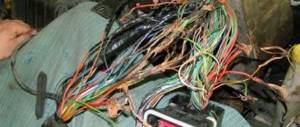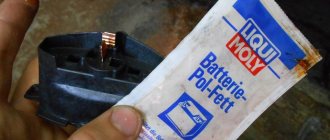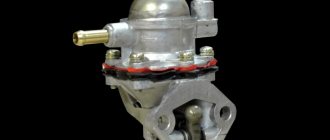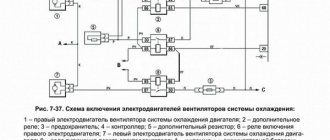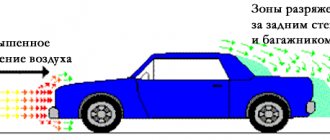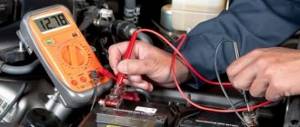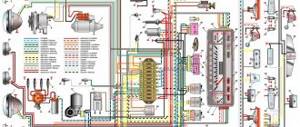What is a high voltage wire
In gasoline internal combustion engines, the combustible mixture is ignited forcibly using a high-voltage spark discharge. The ignition system is responsible for the formation and distribution of discharges among the cylinders. One of the most important places in the ignition system is occupied by high-voltage wires that supply a high-voltage current pulse to the spark plugs.
High-voltage wires have the following place in ignition systems:
- Between switching devices and spark plugs. In contact ignition systems, such a device is a distributor (distributor), in non-contact ignition systems - a sensor-distributor, in microprocessors - a switch;
- Between the ignition coil and the switching device.
The number of wires corresponds to the number of spark plugs; one or two more wires connect the coil to the switching device.
Which high-voltage wires are better
When choosing among analogues of a given spare part, buyers want to choose the best manufacturers in terms of quality or price. In February 2020, the TOP 10 best high-voltage wires on PartReview looked like this:
- Tesla - 85% positive votes. Average rating: 4.1
- Cargen - 85% positive votes. Average rating: 4.2
- BAUTLER - 83% positive votes. Average rating: 4.1
- Finwhale - 82% positive votes. Average rating: 4.3
- NGK - 78% positive votes. Average rating: 4
- VALEO - 77% positive votes. Average rating: 3.9
- BERU - 76% positive votes. Average rating: 3.8
- SLON - 67% positive votes. Average rating: 3.7
- ONNURI - 65% positive votes. Average rating: 3.6
- TSN - 50% positive votes. Average rating: 3.2
More on the topic Electric cars as the transport of the future in real conditions - how they work
Design and types of high-voltage wires
High-voltage wires, regardless of type, have a fundamentally the same design; they consist of several main parts:
- Conductor;
- Core insulation;
- Contact tips;
- Protective caps on contacts.
Based on the material of the conductor, all high-voltage wires are divided into two large groups:
- With a metal core;
- With non-metallic core.
Wires with a metal core are a classic option that is used less and less today. The wire is based on a stranded copper core with a large cross-section and low resistivity.
Wires with a non-metallic core are a modern solution that has become widespread since the late 1980s. These products are divided into two groups according to the type of resistance:
- Wires with active resistance (with a resistive core);
- Wires with reactance (with an inductive core).
Wires with active resistance are so named because they are based on a resistive core with high resistivity - in electrical engineering terminology, a resistor is an active load, and accordingly its resistance to current is called active.
Reactance wires are so named because their core is additionally surrounded by a single-layer winding - an inductor. According to the terminology of electrical engineering, a coil is a reactive load, and accordingly its resistance to current is called reactive.
The simplest structure is for high-voltage wires with active resistance. They are based on a conductive core surrounded by a conductive winding with high resistance and insulation. The core can be made of cotton or linen thread, carbon fiber (Kevlar), fiberglass and plastics. Conductive properties are ensured by sprinkling (impregnation) with graphite or soot. The conductive winding is made of ferroplasts - silicone or special acrylic-based plastics with the inclusion of metal chips.
Wires with reactance are somewhat more complicated. They are also based on a current-carrying core, surrounded by ferroplast, on which a winding of stainless wire is located. This entire structure is enclosed in insulation.
According to the insulation design, wires are divided into two types:
- Simple single layer insulation;
- Double layer insulation;
- Multilayer insulation.
Single-layer insulation is a simple shell made of polymer dielectric materials. This type of insulation has low qualities and is therefore almost never used today. An improved option is double-layer insulation, which consists of an inner layer of main insulation and a top layer that protects against oils, fuel, technical fluids, mechanical contact with engine parts, temperature changes, etc.
Multilayer insulation consists of three layers:
- Internal insulation - directly surrounds the core, is the main protection against electrical breakdown;
- Braid - surrounds the internal insulation, is made of synthetic fibers or fiberglass, provides high tensile strength of the entire product, protects against deformation, etc.;
- Outer sheath - surrounds the entire wire, protects from the aggressive environment of the engine compartment.
Most often, the insulation is made of PVC, polyethylene (the cheapest options), various rubbers and silicone (on modern wires).
High-voltage wires have standardized tips (most often according to the SAE standard); on the spark plug side, tips are of two types:
The tips are covered with protective caps made of rubber, silicone and other dielectrics.
Device
Current high-voltage wires have the following composition:
- Conductive conductor. Divided into types:
- made of copper (stranded). Has a resistance of 0.02 Ohm/m. In addition to such wires, resistors are needed to suppress interference;
- without the use of metal in the filling, with a metal coating. The distributed resistance limit is 2 kOhm/m. The main part of the core consists of a fiberglass coating (graphite impregnation, linen thread, Kevlar). Often, it has a ferroplast coating - it prevents an increase in unwanted vibrations due to its characteristics. A thin metal wire is wound on top. There is a need to use additional suppression resistors;
- without using metal in the filling. Such a core has a high distribution resistance, and the wiring itself does not require resistors. The materials used to make such a core can be different. The most popular: 1) cotton yarn impregnated in a solution of soot (resistance range: from 15 to 40 kOhm/m); 2) polymer “core” (sometimes there is a reinforcing thread inside). Resistance: from 12 to 15 kOhm/m; 3) fiberglass threads sprinkled with graphite.
- Insulation (protective layer). The insulating coating (protection of the dielectric surface of the conductor core) of the wiring can be of two types:
- with one layer;
with several layers.
Purpose of insulation:
- avoiding current leakage;
- protection of the core from moisture, aggressive fuels and lubricants, from high temperatures in the engine compartment, and mechanical defects.
- ensure reliable interaction with the ignition system components. Dirt should not settle on the contacts;
More on the topic The car receives an electric shock when exiting
Characteristics of high voltage wires
The main characteristics of high-voltage wires are electrical resistance. A high-voltage wire is a source of radio interference, and the lower the electrical resistance of the wire, the greater the droppings. There are two ways to reduce the level of interference - by installing a resistor in the high-voltage path, or by increasing the resistance of the wires themselves. Today they resort to both methods, so the wires are divided into three groups according to resistance:
- With “zero” resistance - wires with copper conductors, their resistivity does not exceed 0.022 Ohm/m;
- With low distributed resistance - wires with a non-metallic core and inductive type of resistance, their resistivity lies in the range of 1-6 kOhm/m;
- With high distributed resistance - wires with a non-metallic core and a resistive type of resistance, their resistivity lies in the range of 12-40 kOhm/m.
Problems
Example of damage to a high-voltage wire
- Lost connection. The electrical circuit is often interrupted at the junctions between the metal contacts of the wiring and the conductor (conductive). A break can also occur: when the wire is disconnected;
- in case of unreliable interaction of certain components of the ignition system;
- when the vein oxidizes.
- Current leaks. The cause of the leak may be:
- dirty wiring;
- distribution cover;
- ignition coil;
- the insulating layer is damaged.
- faulty wiring caps. The voltage drops due to clogging of the wiring, spark plugs, distribution cap, ignition coil, when the insulation and wiring caps are damaged.
dirt on spark plugs;
In connection with the above, the dielectric characteristics of these parts become worse during operation.
Prerequisites:
- Low temperatures. They have a detrimental effect on high-voltage wires, making them more rigid/inflexible. This can lead to damage to their insulating layer and caps.
- Constant vibration. It occurs during operation of the power unit and loosens the joints - this negatively affects the contacts.
- High temperatures. The spark plug caps are destroyed, because the spark plugs themselves are in close proximity to the heated parts of the power unit.
- Precipitation. Gradually, the components of the ignition system become covered with various deposits (dust, dirt, vapors, oil, etc.). These deposits serve as a current conductor, which significantly increases the risk of leakage. Damaged insulation significantly reduces voltage.
What you need to know
- When purchasing, you should carefully inspect the packaging for indications of the car/engine models on which this wiring can be integrated.
- Do not install wiring that has a high distributed resistance on a vehicle to which the ignition system generates a high-voltage pulse with a minimum of energy. This is fraught with a decrease in spark power, which will lead to partial ignition of the combustible mixture (starting a cold engine).
- The resistance of high-voltage wires can be determined using a tester. But wiring that is wrapped around a conductive core will not allow this to be done due to the variable resistance value on the power unit at the time of its operation (design features).
- Wiring insulation layer materials. You need to choose wires that match the voltage in the ignition system of a specific car model. The maximum voltage, indicated in the repair and maintenance manual for a specific vehicle, should not allow breakdown in the insulation. The optimal choice is wiring whose insulation and caps are resistant to low/high temperatures (silicone base). In addition, such wiring does not accumulate moisture and liquid, which reduces the risk of electrical leakage.
- Wiring must be clean and dry throughout the entire operation of the vehicle. Cleanliness can be maintained by wiping the distributor cap, spark plug insulators, ignition coil, and the wires themselves with caps previously removed from the engine with gasoline.
- You can detect damage to the insulating layer during operation of the power unit by ear (clicks) or visually. With the hood open (in the dark), sparks should be visible. A glow may also occur near the ignition system devices - this is due to high air humidity/significant current leakage.
More on the topic Car helmet for motorsport - the main differences
Damage to the wire wrapped around the current-carrying core (non-metallic) is indicated by the characteristic “triple” of the motor at high speeds. Then the wire leading to the spark plug is faulty; if the central one is damaged, the engine stalls.
It is necessary to ensure the tightness of the caps in places where the wiring interacts - this reduces the risk of oxidation of the tips with subsequent deterioration of the contacts. Therefore, it is not recommended to press the caps all the way. If cracks appear on them, replace them.
Correct selection of high-voltage wire
When selecting high-voltage wires, three things should be considered:
- Type of ignition system;
- Type of candles used;
- Types of contacts on the coil(s) and switching device;
- The location and distance of the spark plugs from the switching device, the relative location of the switching device and the coil.
For contact ignition systems, it is necessary to choose wires with low (no more than 2 kOhm) resistance; the same wires are recommended to be used when using spark plugs with resistors (the marking of such spark plugs contains the letter “P” or “R”). For older cars, it makes sense to use regular copper wires with built-in resistors.
For non-contact ignition systems, it is recommended to use wires with high resistance (up to 16 kOhm); the same wires can also be used in conjunction with spark plugs without a resistor. Combining high-voltage, high-resistance wires with spark plugs equipped with resistors can cause sparking.
As for the remaining characteristics, they are individual for individual models or model ranges of cars. Therefore, you need to choose wires according to the recommendations of their manufacturers - usually the applicability of the wires is indicated on the packaging. Using wires with a different type of lugs or a different length may disrupt the operation of the system and the entire power unit.
There are two types of high-voltage wire kits available for purchase:
- Set of spark plug wires - only for connecting the switching device and spark plugs;
- A set of spark plug wires with an additional coil wire (wires) - contains a wire or wires for connecting the coil to the switching device.
Correct selection of high-voltage wires guarantees normal operation of the ignition system, ensures lower fuel consumption and generally improves vehicle performance.
Author:
Maxim Markov
Stable engine operation depends on the action of several control systems and sensors at once. One of the main elements is the car's ignition system. The final link that participates in the spark formation process is the spark plugs and spark plug wires. If deviations occur in the stable operation of the motor, wear of high-voltage wires is one of the possible causes of failure.
Diagnostics of high-voltage wires
How to check high-voltage ignition wires in a car with your own hands?
You have several options:
- For the first you will need a lamp and a piece of wire. First, you need to expose the edges of the wire, after which one end of the wire is fixed to the negative of the car battery, and the second is brought to the lamp contact. You need to perform similar actions with your own hands with the other end of the high-voltage - it is connected to the positive output of the battery, and the second output is connected to the lamp body. If the lamp lights up, then do-it-yourself diagnostics indicate that the high-voltage circuit itself is operational.
- Another DIY diagnostic option is without using a lamp, but you will need the wire itself. First you need to start the engine, and the speed should be low. If the engine does not start, then it is necessary for an assistant to turn the starter. The high-voltage circuit itself must be brought close to the engine ground - when you try to start the engine, a spark should jump between the wire contact and the ground of the car; if there is none, then the high-voltage circuit needs to be changed or the spark plugs must be diagnosed.
Purpose and service life
The work performed by the wires becomes clear from the name. During engine operation, high-voltage current is supplied to the spark plugs for the purpose of timely spark formation in the cylinders. The generated voltage reaches 50 kV. In the process of transmitting current, the side process of heating the wiring is almost inevitable. By using insulation, the car body and components are simultaneously protected from electric leakage.
The maintenance schedule for almost no model does not establish a service interval for replacing wires. Usually the installation of new spark plugs is normal. Most often, this indicator is set at 30 thousand km. When servicing the car privately and normal engine operation, the spark plugs work up to 50 thousand km. Typically, high-voltage ignition wires are visually inspected at this very moment.
Design features of high-voltage wires
The design of the wiring does not differ in design options, but differs in the materials used. Wire includes:
- conductor of electric current;
- metal tips;
- insulating material.
The main difference between high-voltage wires and the rest of the wiring used in the car is their large cross-section, which is associated with the work performed.
The insulating caps in the places where the wiring is attached are made in a shape that takes into account the design features of the places where the spark plugs are installed. The reliable performance of metal caps and insulators is associated with the functions they perform:
- Ensuring reliable contact with spark plug leads. This will avoid sparking and irreversible energy loss.
- Protection of the connection from external influences. Moisture must not enter the electrical connection.
- Ability to resist corrosion in the face of significant temperature changes.
Car manufacturers are inventing new ways to route wires to spark plugs and reliably cover the contact point. However, high drive loads lead to fatigue wear, and if operating efficiency decreases, these elements will need to be replaced.
Signs of wear on ignition wires
Damage to wire insulation rarely occurs suddenly. Increasing wear is usually more typical. This is due to the insulation material, which is subject to natural and resource aging. The following engine operating symptoms deserve attention:
- Difficulty starting the engine at any time of the year;
- unstable engine operation at idle speed;
- the appearance of radio frequency interference affecting other operating electronic devices;
- incomplete combustion of fuel in the cylinders, changes in the composition of exhaust gases.
More serious leaks manifest themselves in constant failures of the electronic control unit, disruption of the operation of one or more cylinders. This manifests itself in the form of additional engine vibration. It's time to diagnose the insulation condition and, if necessary, replace worn wiring.
